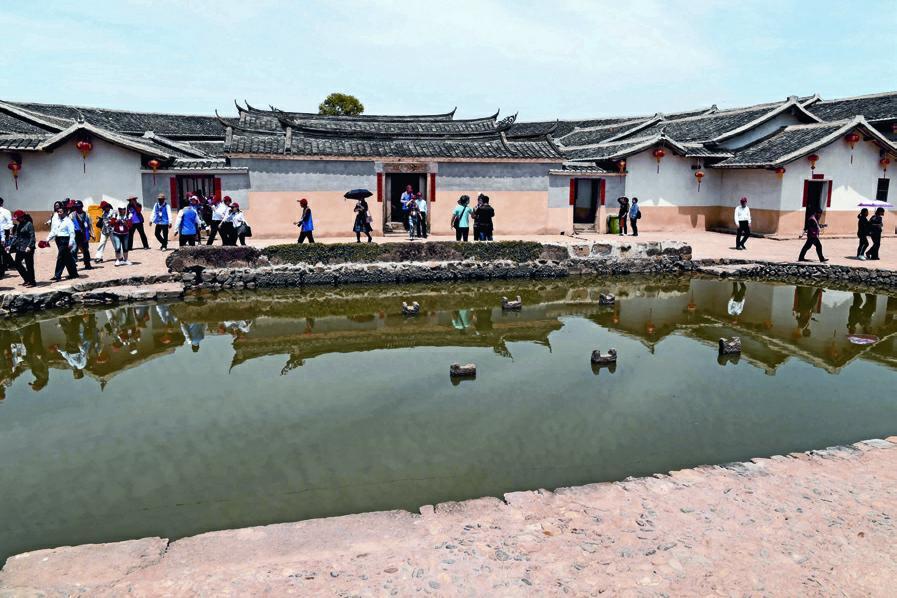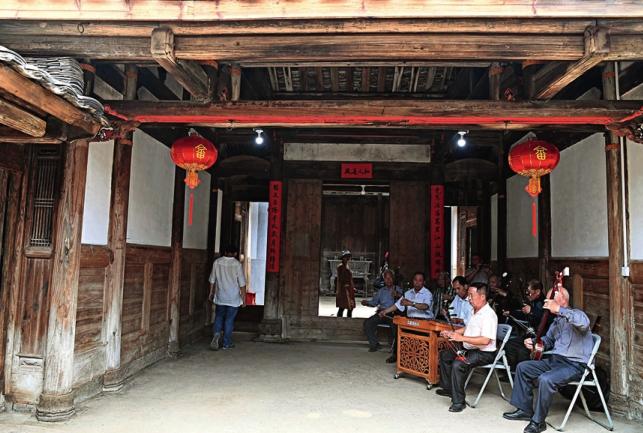The Hakka Coiling Dragon House
By GUO ZHIDONG


COILING Dragon Houses can be found across Meizhou City of Guangdong Province, and are a major type of residential buildings for the Hakka, a sub-group of the Han Chinese. Most buildings are 200-500 years old. Having a distinctive architectural style and conveying a unique culture and customs, they are a key symbol of the Hakka people.
The history of the Coiling Dragon House harks back to the Tang Dynasty (618-907), and reached its pinnacle during the Ming and Qing dynasties (1368- 1911). Its origins can be traced back to as early as the Western and Eastern Jin dynasties (265-420), when wars and famines caused a massive migration of Han people on the Central Plains to southern regions, where they were registered and identified as the“guest,” the Chinese meaning of Hakka.
To protect themselves from bandits and beasts, these migrants lived with their family clans, and built their homes in close vicinity to each other. This lifestyle resulted in communal houses of various designs, of which the Coiling Dragon is the most popular.
The Coiling Dragon House is often built on the conjunction of a hill/slope and plateaued land, and hence gives it the appearance of a curvy shape that is higher in the rear and central parts. Rows over rows of rooms stand in a semi-circle, separated by a strip plaza (for communal activities and sunning) from a semi-circular pond (for aquatic farming, irrigation, and firefighting) in front of them. The height of the rooms rises gradually from the front rows to the rear ones, allowing for better lighting, ventilation, and drainage. On the central axis are the upper, middle, and lower central rooms, which are respectively designated for ancestral worship, deliberation of major clan affairs, and band members and sedan-chair carriers during weddings and funerals. Between the central rooms are public meeting rooms, and besides them are other rooms for various purposes. They are artfully aligned and inter-connected by doorways.
On the periphery of the compound are encircling rooms, which stand in the shape of a coiling dragon, from which the name of this type of house originated. They constituted a line of defense in time of war and unrest: residents could survey the situation outside and shoot outwards through the small windows. The compound also has multi-story corner towers where the family in times past stored war supplies and fired at attackers from above.
A half-moon-shaped garden lies between the encircling rooms and those behind them. It is paved with cobbles or gravel, and the crevices between allow for a free flow of the “vital energy” between the ground and the atmosphere around. For Hakka people, this spot commands the best Fengshui. The garden is separated from the rooms behind the encircling rooms by a ditch, which is part of the sewage system and aimed to keep the rooms dry.
The number of the rows of rooms inside the enclosure and their layouts vary from house to house, so does the size of the compound – ranging from 1,000 square meters at the low end to over 10,000 square meters or larger at the higher end. A large house can shelter hundreds of people. With all facilities and amenities for basic daily needs, such as a well for water and pens for pigs and chickens, such houses can support a secluded, self-contained life.
The Coiling Dragon House is mainly built with earth and wood. When building their houses, the Hakka people would first erect the walls, one meter thick and at least 15 meters tall, with abodes; after that, they would add sand, gravel, straw, bamboo twigs, glutinous rice, and brown sugar among other ingredients into the mud to make the wall stronger. After the mud dries and hardens, the wall is white- washed, and the roof covered with dark tiles. The two contrasting colors give off a rustic, tranquil vibe. Furthermore, the yard is dotted with carefully placed rocks and miniature landscapes, and the beams and doors carved with animal and floral patterns, adding a fine artistic touch to the house.
It takes five to 10 years or longer to build a Coiling Dragon House. During the construction, members of the extended family and all neighbors would come together to help. For reciprocity, the residents would throw a lavish party on the day they would move in. This custom embodies and reinforces the solidarity and spirit of mutual-aid among the Hakka people.
As a Coiling Dragon House is typically shared by family members of several generations, its design and the distribution of rooms among its occupants are in line with traditional values and ethics, such as regard for seniority and a strong sense of family and clan. Some elements of the house imbue ideas of Chinese philosophy. The semi-circular pond and garden, for example, loosely resembles the Taiji diagram, a nod to the ancient belief of harmony between man and nature.

